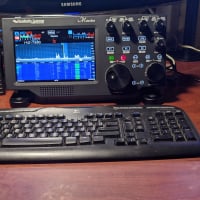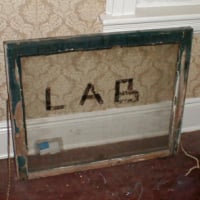Welcome to the FlexRadio Community! Please review the new Community Rules and other important new Community information on the Message Board.
Need the latest SmartSDR or 4O3A Genius Product Software?
SmartSDR v4.1.3 | SmartSDR v4.1.3 Release Notes
SmartSDR v3.10.15 | SmartSDR v3.10.15 Release Notes
The latest 4O3A Genius Product Software and Firmware
SmartSDR v4.1.3 | SmartSDR v4.1.3 Release Notes
SmartSDR v3.10.15 | SmartSDR v3.10.15 Release Notes
The latest 4O3A Genius Product Software and Firmware
If you are having a problem, please refer to the product documentation or check the Help Center for known solutions.
Need technical support from FlexRadio? It's as simple as Creating a HelpDesk ticket.
Need technical support from FlexRadio? It's as simple as Creating a HelpDesk ticket.
PGXL Drive Power SSB

Tom OBoyle
Member ✭✭
Hello All -
I have a PGXL Amp and have been primarily CW operator before. I can set the radio drive to 30 watts CW for 1500 watts out. If I leave the radio at 30 watts and switch to SSB, I see 200 - 400 watts PEP out on my Diawa meter. If I move the power to 50 watts drive, I can see 600 watts or so. This is pretty similar to value on the Amp's meter as well.
If I adjust the audio and overdrive it, I might be able to get 900 to 1000 watts out. If I adjust the audio so that I am not over driving the mic / processing and set the RF drive to 75 watts or so, I can get 1200 watts out BUT I am afraid I am putting out a bad/dirty RF signal then.
What is the right answer here? How do others get 1200 - 1500 watts PEP with 30 - 50 watts of drive and not over-driving the audio?
73 de Tom, N9GUN
I have a PGXL Amp and have been primarily CW operator before. I can set the radio drive to 30 watts CW for 1500 watts out. If I leave the radio at 30 watts and switch to SSB, I see 200 - 400 watts PEP out on my Diawa meter. If I move the power to 50 watts drive, I can see 600 watts or so. This is pretty similar to value on the Amp's meter as well.
If I adjust the audio and overdrive it, I might be able to get 900 to 1000 watts out. If I adjust the audio so that I am not over driving the mic / processing and set the RF drive to 75 watts or so, I can get 1200 watts out BUT I am afraid I am putting out a bad/dirty RF signal then.
What is the right answer here? How do others get 1200 - 1500 watts PEP with 30 - 50 watts of drive and not over-driving the audio?
73 de Tom, N9GUN
0
Answers
-
Good Morning Tom,
PEP Output indications are the toughest thing to accurately measure INDICATE, Believe and in the end Be Happy With. ...sigh.... When you're on CW life is simple. PEP = Average. Push the Key, when the amp gets to 1500W out also taking into account any reflected power which also falsely adds to your forward power and you're done. The FCC expects to see a calibrated, tested Certified PEP meter hanging before the Antenna. The only one I have EVER heard of them accepting is the Bird PEP, however there's a LOT of others out there. The one in your amp is not certified. However you're worried about signal purity with your question.
The indicator does have a peak power BAR in red... however it is not REAL TIME, it lags 100msecs according to the PGXL manual. Fortunately, There's a Harmonic 400W Dummy Load inside the amp PLUS the built in APC that will keep you from really throwing **** out the tailpipe and pre distortion goodies.
Want to be legal? Hang an Oscilloscope on your output. and then figure out how to read it and calculate PEP... The FCC expects that Bologna, however it's WAY past Extra Class or even COMMERCIAL Class licensing. They are going to make you feel really uncomfortable if you ever have to explain yourself.
A (SK) good friend of mine had the FCC enforcement guys knock on his door back in the 1980's, his shack had all the latest goodies, but no Scope ETC. After making him squirm for a while each spent several minutes whistling into his microphone until they hit the sweet spot and saw the meter go above the 1500W PEP mark. Then wrote the ticket of violation... He's like I don't operate it like that!!! funny huh? So how should you run your PGXL? Never let that red PEP bar go over the 1500 mark. On your calibrated PEP output meter at the end before the antenna Never see your needle or digits go beyond 1500W and have a nice day.
Bring up your driver and Whistling up 1500 is the way the FEDS do it. Puts a smile on my face and I shake my head. Remember no matter what have a really good PEP meter as the last thing before tuning units and antenna.
I'm sure somebody including the company has a different procedure, I read the manual after seeing your post. You'll NEVER see the the meter wiggling around the 1500 mark when talking.. Maybe 750+ and even then you'll probably be pushing legality. When we received the 1500PEP power increase IT was a HUGE a HUGE power increase on CW from 1000 input. on SSB and AM it added a lot of complexity to our lives on AM it was a HUGE power CUT! Start at the power it takes to get 1500 average on cw, and bring it up slightly from there... Manual says 50W You'll have a tough time breaking the PGXL.
Erika DD
1 -
Unfortunately both the wattmeter in the PG-XL and wattmeter on the SSDR screen are useless when operating in the SSB mode. Hopefully FRS and 4o3A will eventually resolve this issue. In the mean time I use a Telepost LP-700 Digital Station Monitor. This device reads average and peak power.
2 -
I use the LP-500 with dual couplers that assist in adjustment for linearity (trapezoid display). This really helps keep your signal clean. I had always received good reports, but was surprised to see how non-linear my signal was the first time I connected the LP-500. I now have precise drive levels and evidence that the signal is clean.3
-
I have the LP-700 as well with the couple as well. This is the way to do it. You can visually see everthing you need to adj properly0
-
Since this morning I looked up the info on the LP-500/700, now there's a modern device for doing what I was talking about, monitoring your signal. I'm glad I posted to this thread, learned about a modern product today... :-)
0 -
How do you get a red PEP bar? I've never seen it on my PGXL-before or after upgrading to the latest PGXL utility software. I need to set the 6600M to about 60 watts or more to get 1500 W out of the amp in cw key down.??0
-
I dont own one, I just have a ton of amplifier and transmitter experience in both HR and Commercial BC applications. I'm hoping to get one whenever. I dont believe the watt meter on the amp reads pep. There is a red section on the scale. So far I read the manual this morning in response to the post. I have a considerable power difference between my 6500 readings and my 100w Bird 43 slug without a pep mod... I'll get 75 out of the ssdr and ddutil, and 85-90 on the watt meter depending on band. So I can't answer why you are seeing higher drive to get 1500 out. I've got high main voltage at our place, theres variables at every level from the cable between the rig and the amp on to the end. This LP-500/700 looks like a nice device... those who actually have the PGXLs are going to need answer the smaller variables at this time. Getting actual drive and swr between amp and rig and power out measured at the output to a dummy load. Then cross reference indicators I apologize for any miss info on the pgxl itself. Sure wish one was sitting here. Erika DD0
-
The interesting thing to me is figuring out what works on what bands and what modes. For me I base it on expierence and learning how to use this new to me Amplifier. The other items are AC power in your and this taken from 403a manual. What is MEffA? And when to use MEffA, Mode AB, or Mode AAB. MEffA was invented by 4O3A himself and stands for (Maximum Efficiency Algorithm) and this feature noticeably increases the efficiency of the amplifier when processing constant level tones or non-AM signals, such as CW, RTTY, FM or FT-8 type signals. It works by decreasing the drain Voltage on the amplifier devices, requiring more drive, which moves the amplifier closer to a higher efficiency “Class C” operation. It is only available in “AB” mode. It is not applicable to amplify signals with a varying amplitude, such as SSB, AM, or PSK-31. These modulation modes require the use of Mode “AAB” which provides maximum linearity, but at a lower efficiency than Mode “AB” because you are operating closer to operating the amplifier at Class “A”. Important Note: Though the MEffA box may be checked in the PGXL Windows App, it is active only when the amplifier is in Mode “AB” and has no effect in Mode “AAB”. You can operate in Mode “AB” without MEffA enabled, which still offers mild improvements in amplifier efficiency, especially for constant level signals, relative to maximum amplification linearity. Adjustment of MEffA at a desired power level requires a “tuning” procedure. Key the amplifier with a “Tune” or drive signal, to establish the desired output.Unkey the amplifier then re-key. (You may note that the amplifier drops the Drain Voltage and see the corresponding drop in output level). This is MEffA working.Increase drive to re-establish the desired output level. Then repeat the process (starting with step 2 until the desired output power is achieved for every time keyed.You are now ready to operate. If you don’t want to go through this process, you can leave MEffA off (box unchecked in the PGXL Windows application) and use a fixed drive level that should always correspond to a fixed power output for a given band. Ian Km4cqg0
-
I can get 1500 watts on my Diawa meter with 32 watts of drive on 40m in CW key down. On the amp utility on the PC it shows about 1250 or so. If I set the drive to 40 watts, I get 1400 on the amp but over the max (beyond 1500) on the Diawa meter.
I'm no expert at all at amps but I think my results are more consistent with what others have seen.
Tom0 -
Thanks all. I will look at the LP 500. Maybe Santa can supply one next year
 0
0 -
thanks for all the comments
Still looking forward to some software upgrades to improve the amps power output visibility0 -
Ian,
Thanks for the explanation. This confirms with what I have been seeing (power drop then re-adjust to max) in Meffa mode in CW, FT-8.
Looking now for a comparison between the LP-500 and 700
Jim - W5AP0 -
Only difference is screen size, nothing more on the LP.0
-
For the record, MEFFA, aka dynamic bias, has been around for decades.0
-
I suspect this issue has been know for quite awhile. Note the external peak reading meters being used during the introduction of the PG-XL back in January 2016: https://www.youtube.com/watch?v=Y21oENK8-OE
0 -
LP-500 5" screen vs LP-700 has a 7" screen (measured diagonally). As Gary mentions above, everything else is the same.
A minimal of one coupler is required. Two couplers are required if you wish to use the Trapezoid pattern feature.0 -
Meffa is not dynamic bias. It controls drain voltage.1
-
Fundamentally, however, it takes the envelope of the input signal to set the output power. No? Commercial use amplifiers have been doing so forever.0
-
I'm happy to see 4O3A monitors this forum. 4O3A, can you please tell us PG-XL owners if we can eventually expect a firmware upgrade that will provide a Peak SSB reading on the amplifier display?
0 -
No. It controlls efficiency ... Modulated power supplies are best but more expensive solution. MEffA is simpler, cheaper, and very effective 730
-
Hi Ranko,
Since you are monitoring this thread, could you please comment when PGXL Windows SW will be fixed? Flex says it in works but no commitment day yet.
PGXL is out for a while and it is weird that no fixes available yet.
Thanks and Happy New Year!
KN7K
0 -
First, HNY to all of you. I have few tasks on To Do List and this one of them. We are working on few different solutions for better metering. I expect to have Alpha version in a month. With latency we have over the IP, it is not easy, but it is doable. 732
Leave a Comment
Categories
- All Categories
- 379 Community Topics
- 2.1K New Ideas
- 631 The Flea Market
- 8.3K Software
- 123 SmartSDR+
- 6.4K SmartSDR for Windows
- 184 SmartSDR for Maestro and M models
- 430 SmartSDR for Mac
- 272 SmartSDR for iOS
- 259 SmartSDR CAT
- 195 DAX
- 382 SmartSDR API
- 9.3K Radios and Accessories
- 39 Aurora
- 265 FLEX-8000 Signature Series
- 7.2K FLEX-6000 Signature Series
- 950 Maestro
- 56 FlexControl
- 866 FLEX Series (Legacy) Radios
- 925 Genius Products
- 463 Power Genius XL Amplifier
- 337 Tuner Genius XL
- 125 Antenna Genius
- 297 Shack Infrastructure
- 209 Networking
- 460 Remote Operation (SmartLink)
- 144 Contesting
- 788 Peripherals & Station Integration
- 139 Amateur Radio Interests
- 1K Third-Party Software



